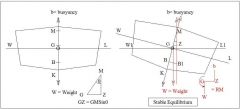![]()
![]()
![]()
Use LEFT and RIGHT arrow keys to navigate between flashcards;
Use UP and DOWN arrow keys to flip the card;
H to show hint;
A reads text to speech;
31 Cards in this Set
- Front
- Back
- 3rd side (hint)
|
Light Displacement |
Weight of the hull, engines, spare parts and water in the boilers and condensers to working level. |
Ship when built (hull and machinery) |
|
|
Load Displacement |
Weight of the hull and everything on board when floating at any particular draught. |
|
|
|
Deadweight |
Difference between the load displacement and the light displacement i.e. the weight of cargo, fuel, FW, ballast, stores, crew, passengers and effects. |
|
|
|
Summer Load Displacement |
The weight of the hull and everything on board when at the summer loadline mark. |
|
|
|
Centre of Gravity (G) |
This is the point at which the entire weight of the vessel is said to act downwards. Its value is equal to displacement. The position of G is entirely dependent on the weight distribution within the vessel. |
|
|
|
Draught |
The depth of the vessel measured from keel to waterline. |
|
|
|
Freeboard |
The distance from the freeboard (uppermost complete) deck to the waterline. |
|
|
|
Initial Transverse Metacentre (M) |
It is the point of intersection of the vertical through B when the vessel is upright and in the slightly inclined positions. M may be considered to be a fixed point up to an angle of 15°. |
|
|
|
Initial Metacentric Height (GM) |
It is the distance measured along the centreline between G and M in the initial upright position. GM is often used as a measure of the stability of a vessel and can be calculated by GM=KM-KG. |
|
|
|
Height of the Metacentre (KM) |
It is the height of M above the keel. Note that KM=KB+BM. |
|
|
|
Centre of Buoyancy (B) |
The geometric centre of the underwater volume. It is the point at which the vessel buoyancy is said to act vertically upwards. Its value is equal to displacement. |
|
|
|
Density |

Mass per unit volume and has this formula. |
|
|
|
LCF |
Longitudinal centre of flotation. It is the geometric centre of the waterplane area (at that draught.) |
|
|
|
Trim |
The difference between the forward and after draughts. |
|
|
|
Change of Trim (COT) |
The difference between the original trim and the final trim. |
|
|
|
LCB |
Longitudinal centre of Buoyancy. The point longitudinally, where all the upthrusts due to buoyancy may be considered to act vertically upwards. |
|
|
|
LCG |
Longitudinal centre of Gravity. The point longitudinally, through which the total weight (mass) of the vessel may be considered to act vertically downwards. |
|
|
|
TPC |
Tonnes per centimetre immersion. The TPC for any draught is the weight a vessel must load or discharge to change the mean draught by 1cm in SW. |
|
|
|
MCTC |
Moment to change trim 1cm. |
|
|
|
Free Surface Effect (FSE) |
The difference between the actual GM and the effective GM is the virtual loss of GM or FSE. |
|
|
|
Stable Equilibrium |

A vessel is said to be in stable equilibrium if, when inclined to a small angle of heel by an external force, she tends to return to the initial position. |
|
|
|
Neutral equilibrium |

A vessel is said to be in neutral equilibrium if, when inclined to a small angle by an external force, it tends to remain at that angle. |
|
|
|
Unstable equilibrium |

A vessel is said to be in unstable equilibrium if, when inclined to a small angle of heel by an external force, it tends to heel over further. |
|
|
|
Angle of Loll |
The angle to which a vessel with a negative initial metacentric height will lie at rest in still water. |
|
|
|
List |
A vessel is said to be listed when inclined by an internal force. G is off the centreline. |
|
|
|
Heel |
A vessel is said to be heeled when inclined by an external force. G is on the centreline. |
|
|
|
FWA |
Fresh Water Allowance. The number of mm by which the draught changes when a vessel passes from FW to SW and vice versa at the loaded draught i.e. at the loadline marks. |
|
|
|
DWA |
Dock Water Allowance. The number of mm by which the draught changes when a vessel passes from dock water (DW) to SW and vice versa at the loaded draught. |
|
|
|
Cw |
Coefficient of waterplane area is the ratio between the actual waterplane area Aw and that of a rectangle of the same extreme dimensions. |
|
|
|
Cb |
Block coefficient is the ratio between the underwater volume and the volume of the block having the same extreme dimensions. |
|
|
|
Archimedes Principle |
An immersed or partially immersed body experiences an upthrust (Force of Buoyancy) which is equal to the weight of water displaced, which is equal to the weight of the body. |
|

